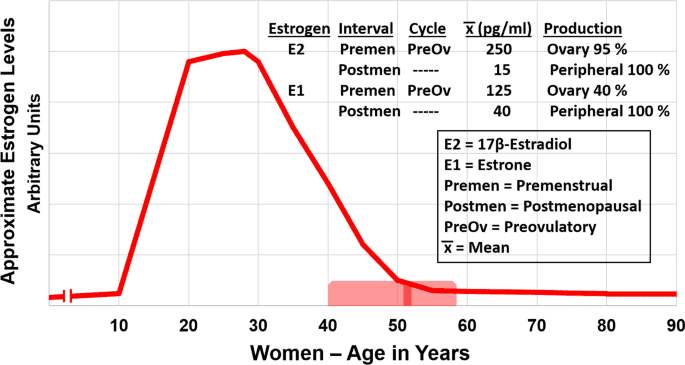
Kim Hoffmann
NASM CES (Corrective Exercise Specialist) and Certified Personal Trainer
As part of our special Menopause Series, this article will explore the benefits of exercise and working out during such a transformative period.
We’ll focus on using three different types of exercise and see how they can help with reducing the effect of menopause symptoms. Let’s first start with the basics and get familiar with our physique.
Women’s physique and exercise
Women tend to be better at long-distance physical activities than men as we have more oxygen-efficient slow-twitch fibers and burn more fat and less carbohydrate during endurance exercises.[1,2]
RELATED — Diet and performance: High-carb or ketogenic diet?

This means we need to adapt our training when we reach menopause.
The main three things women need to take into consideration when programming their workouts are
- strength training
- HIIT
- plyometrics
These three types of exercise will help our body to counter the loss of the hormones during menopause.
Women at menopausal age need very strong stress activities to improve their cardiovascular and heart health as well as their muscle-protein synthesis (protein is produced to repair the muscle breakdown that happens during intense exercise).
First, let’s look into strength training.
Menopause and strength training
Strength training or resistance training consists of two types of exercises:
- Low number of repetitions (5–8 reps) and heavy weight (70–90% of our 1 rep max) to build strength
- High number of repetitions (8–12 reps) and lower weight (60–80% of our 1 rep max) to increase muscle size or hypertrophy.
Training for hypertrophy doesn’t make us stronger
Sure, at the beginning we may find that we’re stronger than before we started training, but strength training is what causes positive changes in our body.

Hypertrophy, other than the initial strength gain, doesn’t add much to our body except for aesthetics.
The strength training that we will be talking about is the “lower number of repetitions with high weight” type of training, where we go for a maximum of 8 repetitions while maintaining correct and proper form.
Strength training can also help with joint aches and pains
This is due to the inflammation as well as loss of oestrogen and progesterone that causes ligaments and tendons to lose strength.
Strength training drives the neuromuscular stimulation to help with fast muscle contractions, and it also puts stress on the bone, which in turn increases bone mineral density.
Women tend to focus on cardio exercise, such as long-distance running and cycling, to lose fat, but we need multi-directional stress that strength training gives to help with bone remodelling.
Another benefit of strength training is that it improves our blood flow by vasodilation of the blood vessels.[3]
Women of perimenopause and postmenopausal age are more at risk of cardiovascular disease, and strength training helps with opening the blood vessels.
Menopause and HIIT (High Intensity Interval Training)
HIIT is the go-all-out workout with short bursts exercises, followed by 10–30 second periods of rest. We should push as much as we can, going for 85–90% of our max heart rate.

The heart rate during the rest period may come down to 70%, but the point of having little rest is so that we don’t fully recover.
The high-intensity interval workouts are great for our overall health because they
- help with power and strength components
- improve our insulin sensitivity, helping our bodies absorb carbohydrates more effectively
- assist with lowering cortisol levels
- assist with lowering visceral and overall body fat
- mitigate stress.

Source: Lephart, E. Menopause and the Skin: Old Favorites and New Innovations in Cosmeceuticals for Estrogen-Deficient Skin. (2021)
Another downside to menopause is that we lose healthy levels of oestrogen and with that, our ability to fight inflammation. Adding HIIT into our exercise regime will improve our ability to downgrade that inflammation because HIIT raises our oestrogen levels.
Also, following a session of HIIT, another benefit happens during our recovery time, when we experience a greater release of growth hormone, or testosterone.
Testosterone all but disappears in perimenopause and postmenopause.[4] A boost of this hormone is beneficial for women because it also
- counters the negative effects of estrone
- lowers cortisol
which would stay elevated after an endurance workout.
HIIT also has a positive effect on the brain
Brain-derived neurotrophic factor (BDNF) is responsible for brain health, which decreases with the lack of oestrogen and with age. Because of the strong stimulus of HIIT, there is an increase of BDNF, which helps with brain tissue remodelling.[5]
This, in turn, triggers other neurotransmitters to improve our cognition and memory. So to sum up, you can’t go wrong with HIIT!
Menopause and plyometrics
This type of exercise includes fast activities such as:
- jumping
- running
- throwing
- kicking
- punching
We want to incorporate some of these exercises to put stress on the muscles, joints and bones, because like strength training, plyometrics improves power and muscle integrity.

It does this by maintaining the fast-twitch fibers and improves our muscle-contraction time, which are essential for general good health.
The idea of any of these workouts and training is to maintain our neuromuscular integrity and muscle – this means our strength, speed and power, which we lose with age but also at the onset of menopause.
Plyometrics work is very easily incorporated in HIIT sessions, as we can see in the next section.
Your workout plan
Many women often wonder how to create a functional programme for perimenopausal and postmenopausal workouts.
Because our menstrual cycle has become irregular, the usual training for 3 to 4 weeks on and 1 week off doesn’t work.
What we do instead is plan a 2 weeks-on and 1 deload week cycle, as below.
Monday | Tuesday | Wednesday | Thursday | Friday | Saturday | Sunday |
Hard | Hard | Easy | Moderate / Easy | Easy | Hard | Off/Easy |
Hard | Hard | Easy | Moderate / Easy | Easy | Hard | Off/Easy |
Moderate / Easy | Moderate / Easy | Off | Moderate / Easy | Easy | Moderate / Easy | Off |
The reason why we’re doing 2 hard sessions back-to-back is because our bodies are able to absorb all that stress.
Also, remember that the deload week is not a rest week. We still want to do some exercise, but only at 50% intensity of our usual hard sessions. It’s important to keep the momentum going and stick to that routine.
An example of a hard workout is an EMOM session (Every Minute On the Minute):
- 20 squat jumps
- 10 push-ups with rotation
- 20 sit-ups
- 15 burpees
- 50 mountain climbers
- 30 Kettlebell swings
For example, you will do 20 squat jumps (don’t mind the time) and then rest for a minute. On minute 2, you will do 10 push-ups, then rest for a minute, and so on. You will keep going until you’ve finished every exercise.
You may want to start with 2–3 rounds at first
As you get stronger, you should be increasing the number of rounds every few weeks.
If you’re a runner or cyclist, I suggest heavy squats or deadlifts, followed by a heavy leg press. To finish it off, go cycling at high resistance and low cadence to keep it heavy.
The idea for the deload week is to give your body a break and a chance to adapt to all the exercise and stress you’ve been putting it under. You can still work out but focus on some functional and mobility work, such as walks, stretching and yoga.
RELATED — Physical and psychological benefits of yoga: Your mind and body will be grateful
If you do endurance sports, you could do some longer distance on these days, but keep it at a lower rate of perceived exertion (RPE). Deload week is there to improve sleep and heart rate variability (HRV).
RELATED — Different types of sleep: Which one do we need the most?
HRV tells us how quickly we’re recovering in high intensity sessions. The faster we recover, the better our HRV, which means that our parasympathetic system is working well, and we’re reducing the amount of stress in our body.
If we go all out in all our sessions, our stress levels will stay elevated and our sympathetic system will stop us from adapting to our training.
Related Questions
1. Can I take a protein shake or bar instead of a meal?
Always try to get all of your nutrients from natural foods. Bars and shakes are often processed, with added sugar.
2. How can I increase my protein intake?
Get creative with smoothies. These should not be a meal replacement, but a snack. You can put anything in a smoothie, from dairy to vegetables.
3. What can I do for recovery after these hard training sessions?
Great diet and great sleep are the most important steps in recovery.
Prioritize protein intake and have some right after your training. Also, leave as much time in between workouts as possible. For example, if you do a workout in the morning, then the following day, have a session in the afternoon or evening.
Other things to consider:
– Take supplements like curcumin (turmeric) or glutamine
RELATED — Turmeric (Curcuma longa)
– Warm up and cool down well with foam rolling, dynamic and static stretching
– Do an active recovery through yoga or easy walks.
– If you do long-distance running or cycling, ice baths might be beneficial as well.
4. What else can I do to make sure I give myself the best chance of easing through menopause?
Talk about it. Share your experiences with friends or colleagues, or join groups that discuss menopause. Menopause starts earlier than most women think, so you might not associate your symptoms with it.
Every workout session needs to have a great foundation, which rests on several pillars. The first pillar is nutrition, and we suggest reading more about it on our page Connecting you with Food, where we discuss different nutrients as well as share some amazing Recipes.
Kim Hoffmann is a certified Personal Trainer and Corrective Exercise Specialist based in Auckland. She also specialises in women’s health and fitness by taking into consideration the menstrual cycle and hormones and implementing them in different workout plans. The workout methods and routines include free weights, suspension straps and boxing, as well as strength training and high intensity.
Kim’s passion is helping people move better and improve their quality of life. She helps men and women of all ages achieve their goals and also offers online classes and consultations. You can see more of Kim at Snatch Fitness.
References
(1) Hicks, A. L., Kent-Braun, J., & Ditor, D. S. (2001). Sex differences in human skeletal muscle fatigue. https://journals.lww.com/acsm-essr/fulltext/2001/07000/sex_differences_in_human_skeletal_muscle_fatigue.4.aspx
(2) Tate, C. A., & Holtz, R. W. (1998). Gender and fat metabolism during exercise: A review. https://pubmed.ncbi.nlm.nih.gov/9822793/
(3) Goto, C., Nishioka, K., Umemura, T., Jitsuiki, D., Sakagutchi, A., Kawamura, M., Chayama, K., Yoshizumi, M., & Higashi, Y. (2007). Acute moderate-intensity exercise induces vasodilation through an increase in nitric oxide bioavailability in humans. https://academic.oup.com/ajh/article/20/8/825/182351?login=false
(4) Guay, A., & Davis, S. R. (2002). Testosterone insufficiency in women: Fact or fiction https://www.bumc.bu.edu/sexualmedicine/publications/testosterone-insufficiency-in-women-fact-or-fiction/
(5) Saucedo Marquez, C. M., Vanaudenaerde, B., Troosters, T., & Wenderoth, N. (2015). High-intensity interval training evokes larger serum BDNF levels compared with intense continuous exercise. https://journals.physiology.org/doi/epdf/10.1152/japplphysiol.00126.2015






